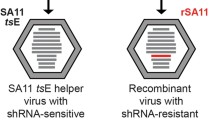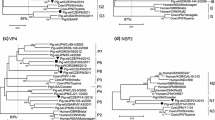Summary
Rotavirus clones Aff5–10 and Aff5–16 isolated from a bovine rotavirus strain Aff5 possess NSP1 gene which has a point mutation generating a nonsense codon and a 500 base-deletion, respectively. As a result, the two Aff5 clones encode truncated NSP1 product which lacks cysteine-rich region forming zinc finger motif. In order to analyze reassortment of these mutated NSP1 gene with RNA segments from heterologous strains, we investigated a number of reassortant clones derived from coinfection with either Aff5–10, Aff5–16 or a reference strain Aff5–13 (possessing intact NSP1 gene) and either simian rotavirus SAff11 or human rotavirus KU. In coinfection with SAff11 and Aff5–13, selection rates of Aff5–13 segments in reassortants ranged approximately from 20 to 70% (46% for NSP1 gene). In contrast, in the reassortment between SAff11 and Aff5–10 or between SAff11 and Aff5–16, selection rates of NSP1 gene from Aff5–10 and Aff5–16 were only 1% (one clone) and 0%, respectively. In reassortants from crosses KU × Aff5-clones, selection rate of Aff5–13 NSP1 gene decreased to 15%, while 11 reassortants with Aff5–10 NSP1 gene (31%) and one reassortant with Aff5–16 NSP1 gene (2%) were isolated. Reassortants with Aff5–10 NSP1 possessed a single gene (segment 9 or 11) from KU in the genetic background of Aff5–10. One reassortant clone (cl-55) with Aff5–16 NSP1 gene possessed KU gene segments 3, 4, and 8–11. When single-step growth curves were compared, the reassortant cl-55 showed almost identical growth curve to that of KU, while KU showed a better replication than Aff5–16. These results indicated that although Aff5–10 or Aff5–16 NSP1 gene encoding the truncated NSP1 is selected into reassortants much less efficiently than normal NSP1 gene, the reassortants with the mutated NSP1 gene and RNA segments from heterologous strains normally replicated in cultured cells. Thus, cysteine-rich region of NSP1 was not considered essential for genome segment reassortment with heterologous virus.
Similar content being viewed by others
Author information
Authors and Affiliations
Additional information
Accepted August 29, 1998 Received July 6, 1998
Rights and permissions
About this article
Cite this article
Okada, J., Kobayashi, N., Taniguchi, K. et al. Analysis on reassortment of rotavirus NSP1 genes lacking coding region for cysteine-rich zinc finger motif. Arch. Virol. 144, 345–353 (1999). https://doi.org/10.1007/s007050050508
Published:
Issue Date:
DOI: https://doi.org/10.1007/s007050050508




